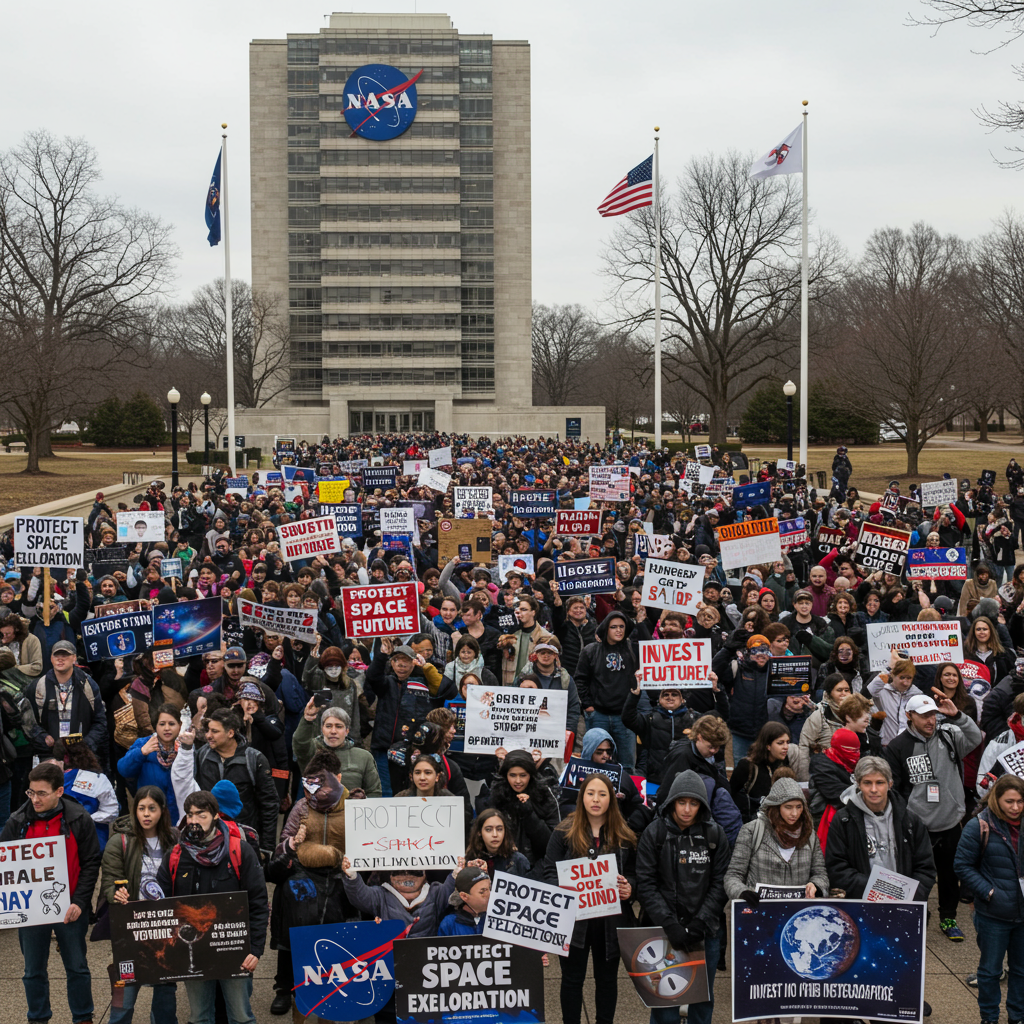Hundreds gathered outside NASA Headquarters on June 30, 2025. They voiced strong opposition to proposed federal budget reductions. These potential cuts threaten key agency programs and jobs. The demonstration aimed to highlight the severe impact of decreased funding. This includes effects on scientific research and space exploration missions like Artemis.
Protesters Rally Against Proposed NASA Budget Cuts
The protest took place as planned on Monday, June 30, 2025. It unfolded from 7:00 am to 11:00 am EDT in Washington, D.C. A crowd of roughly 100 people initially assembled, growing throughout the morning. Participants held numerous handmade signs. Their messages primarily focused on the significant cuts targeting NASA’s budget. Specific concern was directed at funding for NASA’s vital science activities.
Eyewitnesses described a friendly and courteous gathering. There were no reported disturbances. Security presence was minimal. Cars passing by frequently honked and cheered in support. While the overall reach of such events can be limited, the protest made a clear statement. Anyone entering or working at NASA HQ that day saw visible evidence. Employees from Goddard Space Flight Center (GSFC) and Headquarters publicly expressed their stance. They raised concerns about the budget proposals.
The protest maintained a largely non-partisan focus. Signs centered on the budget cuts themselves. They also called on Congress to address the funding issues. An isolated sign referencing a specific political figure quickly disappeared. Organizers and attendees prioritized the core message. They stressed the need to protect NASA’s mission and workforce.
Deep Concerns Over Job Losses and Program Impacts
The core motivation for the protest stemmed from deep anxieties about potential consequences. Reduced federal funding is projected to cause significant job losses across the agency. It also risks hindering critical scientific opportunities. This negative impact extends to NASA’s overall operations and research capabilities. Experts fear crucial programs could face termination.
One of the most cited concerns involves the future of the Artemis lunar missions. These missions represent America’s return to the Moon. They are seen as vital for future space exploration and maintaining global leadership. Proposed cuts could significantly scale back or even end this ambitious undertaking. This prospect alarms scientists, engineers, and space enthusiasts alike.
Beyond flagship programs, the potential scale of the cuts is staggering. Reports suggest a possible nearly one-third reduction in NASA’s overall workforce. This could equate to thousands of lost jobs nationwide. Furthermore, scientific funding could be slashed by almost half. Such a drastic decrease would cripple ongoing research projects. It would also prevent future scientific endeavors.
The Economic and Scientific Toll of Budget Cuts
The potential budget reductions carry significant economic repercussions. This is particularly true for regions hosting major NASA centers. The situation at NASA Glenn Research Center in Cleveland, Ohio, serves as a stark example. Recent proposals target cutting nearly 40% of the civil service jobs there. This means approximately 554 positions are at risk.
Losing over 500 high-skilled jobs has a massive multiplier effect. Each direct NASA job supports an estimated two to three ancillary jobs locally. This economic activity is crucial for regional prosperity. NASA Glenn contributes around $2 billion annually to the Northeast Ohio economy. Cutting nearly 40% of its workforce would drastically reduce this contribution. Local business leaders express deep concern. They view NASA Glenn as a critical “innovation engine and powerhouse.” Proposed cuts jeopardize both regional jobs and the center’s core mission.
Unique Research Capabilities Under Threat
The impact extends far beyond job numbers and economic figures. These cuts threaten irreplaceable scientific capability. NASA Glenn and its related Armstrong Test Facility in Sandusky conduct unique research. This includes vital work in aeronautics and space travel. Crucial studies on new fuels, acoustics, and aircraft icing safety happen here.
Much of this specialized research is not replicated in the private sector. The Icing Research Tunnel at Glenn is a prime example. Experts state nearly every commercial plane flown has been tested there. This testing helps prevent dangerous aircraft icing. Losing such facilities and the experienced teams operating them would be a critical blow. It would negatively affect both national research capacity and transportation safety.
Other vital areas at Glenn also face jeopardy. This includes leadership in power and propulsion systems. Work on cutting-edge nuclear technologies and space communications is also at risk. These areas are essential for future space missions and national security. Experienced civil servants who dedicated careers to this work highlight the broader damage. They see the proposed budget as harmful not just to NASA but to dedicated public servants across many government agencies.
The Political and Agency Landscape
The proposed budget cuts are part of a broader governmental spending plan. This plan has generated varied reactions among political figures. Some lawmakers acknowledge the importance of centers like NASA Glenn. They express intentions to advocate for more favorable resources. Others have previously suggested alternative ideas, like relocating NASA Headquarters.
Lawmakers faced pressure to finalize budget decisions around the July 4th timeframe. The protests served as a timely reminder of the public and professional stakes involved. The outcry aimed to sway political decisions. It sought to protect essential federal investments in science and technology.
NASA management responded to the planned protest internally. They informed employees about potential traffic delays. However, agency leadership made a clear distinction. They emphasized the protest did not represent NASA’s official views. They also clarified it was not an agency-sanctioned event or a strike. Employees were advised that participation should occur solely in a personal capacity. They were cautioned against participating as part of their official duties. This stance aimed to maintain agency neutrality and professionalism during the event. The NASA Headquarters Professional Association (NHPA) echoed this guidance.
Unified Voice Against Cuts
The protest received strong backing from organizations representing NASA employees and the scientific community. The Goddard Engineers, Scientists, and Technicians Association (GESTA) provided significant support. The International Federation of Professional and Technical Engineers (IFPTE) also endorsed the demonstration. GESTA successfully obtained a permit from local police for the event. This organizational support underscores the unified concern among technical professionals and union members.
Reactions from the broader scientific community are overwhelmingly against the proposed cuts. Scientists fear severe impacts on missions and research projects. They also worry about a significant “brain drain” of top talent from the agency. Many believe these cuts would critically diminish the United States’ competitive edge in the global space race. Maintaining robust funding is seen as essential for future innovation and discovery.
Public and social media reactions show mixed views. Many online commenters express support for the protest. They advocate for protecting scientific progress and programs like Artemis. Others argue that fiscal responsibility requires budgetary reductions across government agencies, including NASA. There is also ongoing public debate surrounding NASA management’s decision to distance itself from the employee-led protest.
The demonstration at NASA Headquarters on June 30, 2025, was more than just a budgetary dispute. It represented a significant public call to action. Protesters aimed to preserve America’s leadership in space exploration and scientific advancement. They sought to raise awareness about the widespread negative repercussions of the proposed cuts. The event rallied support for continued, robust science funding. Stakeholders urged policymakers to consider the far-reaching impacts on NASA, its workforce, the scientific community, and the nation’s capacity for future innovation. The fate of these critical programs and jobs now rests with congressional decisions.
Frequently Asked Questions
Why were people protesting at NASA Headquarters on June 30, 2025?
The protest on June 30, 2025, at NASA Headquarters in Washington, D.C., was held to oppose significant proposed federal budget cuts. These cuts targeted vital NASA programs, science activities, and specific centers. Protesters feared the reductions would lead to extensive job losses, hinder scientific research opportunities, negatively impact crucial missions like Artemis, and potentially weaken the United States’ leadership in space exploration.
Which NASA center is most impacted by the proposed job cuts mentioned in the protests?
While cuts were feared agency-wide, specific concerns focused heavily on the NASA Glenn Research Center in Cleveland, Ohio. Proposed plans reportedly aimed to eliminate nearly 40% of the civil service jobs at Glenn, totaling about 554 positions. Protesters highlighted this specific threat due to its significant economic impact on the local region and the risk of losing unique, critical research capabilities housed at the center.
What potential consequences do protesters and experts fear if the proposed NASA budget cuts are enacted?
Protesters, employees, and experts fear multiple negative consequences. These include significant job losses affecting local economies (like the $2 billion contribution from Glenn with its 2-3 job multiplier). They also worry about losing unique scientific research capabilities (e.g., aeronautics, icing, propulsion, nuclear). Broader fears involve hindering overall scientific advancement, causing a “brain drain” of talent, potentially ending key missions like Artemis, and ultimately weakening the United States’ position as a leader in space exploration and innovation on the global stage.
Word Count Check: [Estimated word count: ~1150]



